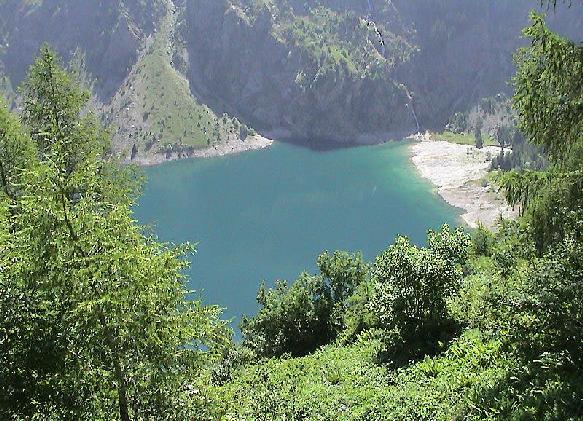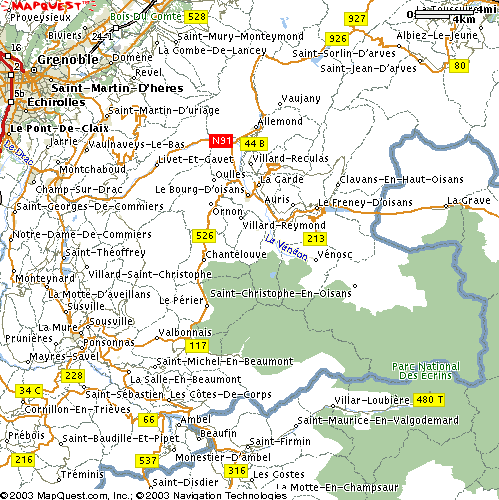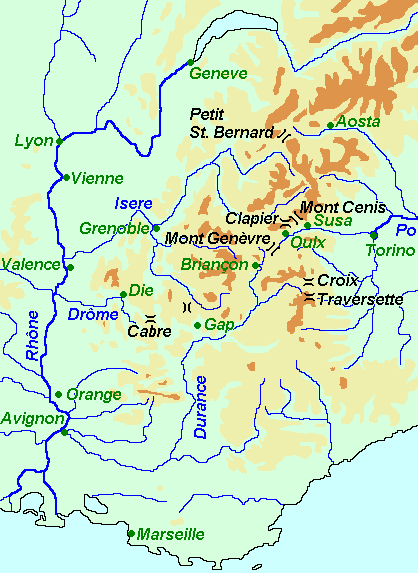Real World Savoy History
 In 1000 AD, Humbert the Whitehanded consolidated an alpine region
of the Kingdom of Burgundy and became Humbert I (the "I" would
be added later, of course, after a second Humbert showed up),
the first Count of Savoy,
at the age of 28. He was, therefore, vassal to
Rudolf III, King of Burgundy, who was himself probably vassal to
the Holy Roman Emperor, Otto III. (Although they would have
called it simply "The Roman Empire.")
In 1000 AD, Humbert the Whitehanded consolidated an alpine region
of the Kingdom of Burgundy and became Humbert I (the "I" would
be added later, of course, after a second Humbert showed up),
the first Count of Savoy,
at the age of 28. He was, therefore, vassal to
Rudolf III, King of Burgundy, who was himself probably vassal to
the Holy Roman Emperor, Otto III. (Although they would have
called it simply "The Roman Empire.")
When Rudolf III died in 1032, his niece Gisela inherited Burgundy, and since she was married to Conrad II, the Holy Roman Emperor, the Kingdom of Burgundy (or Kingdom of Arles, or Burgundy Arelate - many names seemed to be used) became the "Fourth Crown" of the Emperor, along with East Francia (or Germany), Lombardy (or Italy - the "Iron Crown") and Rome. Humbert I was then vassal to Conrad II, Holy Roman Emperor and King of Arles.
Savoy grew more and more independant as the Counts expanded their holdings on both sides of the alps, playing the rulers of surrounding kingdoms off against each other. By 1034, Savoy controlled the Mont Cenis and both Saint Bernard passes, granting himm quite a bit of control over transalpine travel.
In 1189, Thomas became Count of Savoy and ruled until 1233, when he was suceeded by his eldest son, Amadeus IV, who ruled until 1253 when he was suceeded by his son Boniface. (If the saga goes beyond that point, we can look up the following Counts.) It is worth noting that Savoy was divided into smaller estates, and they were divided among Thomas' sons, with Amadeus having the title of Count, the estate of Savoy proper, and lordship over his brothers.
Thomas's liege lord would have been the great Frederick I, Barbarossa, who led the third crusade, but died in 1190. He was succeeded by Henry VI, who also predeceased Thomas, dying in 1197.
Things get dodgy in the HRE, then. Frederick (II) still a minor is not accepted by the Germans, and his uncle Philip, Duke of Swabia, was chosen defender of the Empire. Soon, though, he was elected King of Germany.
Those opposed to his camp, then elected, Otto of Brunswick king, making him Otto IV. Otto still a youth wars with Philip of Swabia until 1208, when Philip's murder ends the competition decisively.
It appears that Savoy under Thomas I favoured Frederick, since I've found a refernce to him being an "imperial vicar" of Frederick II.
In 1212, Otto is deposed and Frederick II takes over, ruling until 1250, but facing several rivals as does his successor Conrad IV. Then in 1254, it all comes to a head and there is an interregnum until 1273.
To summarize, in 1200, Savoy is not an important player in European politics, and is ruled by a Count who owes allegience to the King of Burguny and the Holy Roman Emperor, who are the same person.
Lauvitel
Geography

La Lac du Lauvitel is located far up the Veneon valley, southwest of the
village of Venosc, high in the mountains. The lac is roughly 1km
across.
Venosc is at an elevation of about 750 meters and is on the Veneon river. Lakehome is located perhaps 7 km away, at an elevation of about 1500 meters, and the nearby alps and glacier rise to over 4000 meters. The best route between Lauvitel and Venosc is not as the crow flies, instead one heads north, down the valley to the Veneon river then turns east to Venosc. It's two kilomters to the Veneon valley with nearly all of the 750 meter drop occuring there, and about 100 meters of it almost immediately from the lake.
The snow line is about 2000 meters, so although the Lac is not snowed in year-round, snow is always visible just up the mountain.
The game Lac du Lauvitel is larger than the one pictured here. I believe the real Lac is perhaps 1 km across, ours is 2 km. (Why is the modern lake so much smaller? Does it have to do with the something that will occur in the Saga? Who knows?)
The Lac du Lauvitel is, in our game world, a rough circle two kilometers across,and perhaps 30 or 40 meters deep at its deepest point, with a fairly gently slope from the edges to the center of the lake.
The Lake is fed from above by the rains and snows in the region, as well as by some glacial runoff during the summer. It is fed from below by hotsprings on the lake-floor. This gives it something of an inverted temperature profile - the surface is colder than the bottom. The parts of the lake nearest the springs are warm enough to swim in, even in the middle of winter, although the dive through the cold surface is daunting.
To the north, the terrain drops off steeply, plunging 100 meters vertically in only twenty or thirty meters of horizontal run. The path up is narrow with several switchbacks. It can be negotiated by beasts of burden, if one is careful, but no cart or wagon can make the trip.
There is a little spill from the lake that splashes down on the eastern side of the little valley into a pool, and then a small creek which runs north along the eastern edge of the valley to join the Veneon river.
On the southeast edge is a marshy region which runs right up to a cliff wall. This is the only part of the valley wall which is actually a cliff; the rest is steep, but not actually cliffs.
Game World Lakehome History
Terrus raised a spire of rock from the lakebed in the middle of the lake,
and then tunneled out the initial caverns and passages. The aura
at one fairly small point was extremely strong, and at that point he
carved out his laboratory. The surrounding aura is fairly strong,
and all the areas that have since been excavated are within the aura.
Over the years, Terrus has continually expanded the tunnels, adding
passages and caverns.
The Southern edge of the lake is marshy, and has a faerie aura, although
to date no faeries have been seen. However, a clump of marsh reeds
have proven to be a consistent source of Vis. Each season, certain
reeds provide Vis consistent with their life cycle: Creo in Spring,
Muto in Summer, Herban in Autumn and Perdo in Winter.
Early in 1167, while exploring some interesting underground features,
Terrus found a natural cavern with a pool into which water dripped
slowly from the roof. The pool was not only a source of pure
Aquam vis, but also a natural scrying pool.
While testing a new spell, Boring the Sturdy Shaft, in 1171, Terrus discovered
a magnificent lode of nearly pure silver. The expansion also disturbed
the dwarves who dwell beneath the covenant, earning their enmity.
In 1175, Terrus recruited Osprey of Bjornaer to join the covenant, which
had till then consisted of Terrus alone.
The following year, 1176, Osprey
designed and created the first Torch of Sweet Air, which made the
caverns much more comfortable to dwell in.
1179 was the year the dwarves
first made their displeasure felt in the covenant. Terrus and Osprey
repelled them without too much difficulty.
The Hermes Portal to shore was created in 1183, making Lakehome much
more accessible. In order to cast the Ritual, Terrus required the
aid of another Terram magus, Laurelyn, from Bremerren, putting
the Covenant slightly in her debt.
By 1185, enough Torches of Sweet Air had been made to leave one in each
of the major areas of the cavern complex, and life became much simpler
in Lakehome.
In 1191, twins Castoria and Pollia of Ex Miscellanea joined the
covenant. They sought out Lakehome in particular for its
Aquam connection.
An accident while Terrus was enchanting an object in
his lab resulted in all the weapons and armour in the covenant
being destroyed. Fortunately, it was fairly easy to replace them
with silver from the mine.
Not surprisingly, it was the Twins who discovered an interesting feature
about the lake. It was fed jointly by glacial runoff from above
and also by a hot-springs from below. This gave it something of an
inverted temperature profile - the surface was colder than the
bottom. The parts of the lake nearest the springs were warm enough to swim in,
even in the middle of winter, although the dive through the cold surface
was daunting.
Osprey devoted some time to establishing a small fishing village
on the edge of the lake in 1199, providing Lakehome with a source
of food, supplies and occasional recruits.
The settlements have sprung up both to the west of the lake on
a flat portion of ground and also below the lake on the eastern
side of the little valley.
In 1200, Osprey arranged a trade with several other of the Covenants in
the Tribunal to round out the library. Late in the year, Castoria and
Pollia suffered an accident in the lab, entering a temporary Wizard's
Twilight. When they emerged, their bond, already close, was even closer
to the point where they almost seemed like one person with two bodies
at times.
In 1200, this was a sparsely inhabited, inaccessable region of the
Alps. The major paths across the alps were far away: the Great
St. Bernard pass (not shown) was to the North between Aosta
(Augusta Praetoria) on the
East to Martigny (Octodurus) on the West. The Little St. Bernard
lead from the Val d'Isere to Aosta; the Mont Cenis pass was only slightly
south the St. Bernard passes and connected Vienne and Pavia; the coast road was
far to the south.
Click on the map for a zoomed image of the lac and
Venosc In 1166, Terrus of Tremere left Pandrin to found the Covenant of Lakehome
in a remote lake in the alps near not too distant from Grenoble.
In 1166, Terrus of Tremere left Pandrin to found the Covenant of Lakehome
in a remote lake in the alps near not too distant from Grenoble.
